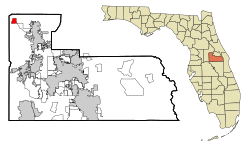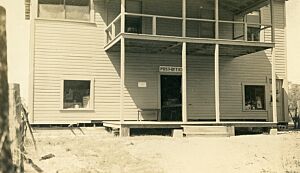Tangerine, Florida facts for kids
Quick facts for kids
Tangerine, Florida
|
|
|---|---|

Location in Orange County and the state of Florida
|
|
| Country | |
| State | |
| County | Orange |
| Area | |
| • Total | 5.29 sq mi (13.69 km2) |
| • Land | 4.55 sq mi (11.80 km2) |
| • Water | 0.73 sq mi (1.89 km2) |
| Elevation | 151 ft (46 m) |
| Population
(2020)
|
|
| • Total | 3,237 |
| • Density | 710.80/sq mi (274.43/km2) |
| Time zone | UTC-5 (Eastern (EST)) |
| • Summer (DST) | UTC-4 (EDT) |
| ZIP code |
32777
|
| Area code(s) | 352 |
| FIPS code | 12-71100 |
| GNIS feature ID | 0292014 |
Tangerine is a small community in Orange County, Florida, United States. It is called a census-designated place (CDP). This means it's an area counted by the government for population, but it's not an official city.
In 2010, about 2,865 people lived in Tangerine. By 2020, the population grew to 3,237 people. Tangerine is also part of the larger Orlando and Kissimmee area.
Contents
Where is Tangerine Located?
Tangerine is located in Florida at these coordinates: 28°45′31″N 81°37′55″W / 28.75861°N 81.63194°W.
The United States Census Bureau says that Tangerine covers a total area of about 13.7 square kilometers (5.3 square miles). Most of this area, about 11.8 square kilometers (4.5 square miles), is land. The rest, about 1.9 square kilometers (0.73 square miles), is water.
Who Lives in Tangerine?
| Historical population | |||
|---|---|---|---|
| Census | Pop. | %± | |
| 2020 | 3,237 | — | |
| U.S. Decennial Census | |||
In 2000, there were 826 people living in Tangerine. They lived in 323 households, and 256 of these were families. The population density was about 716 people per square mile.
Most people in Tangerine were White (91.65%). There were also African American, Native American, and Asian residents. About 8% of the population was Hispanic or Latino.
Many households (31.6%) had children under 18 living with them. Most households (67.2%) were married couples. The average household had 2.56 people.
The population was spread out by age. About 23.2% were under 18. The median age was 42 years old. This means half the people were younger than 42 and half were older.
The average income for a household in Tangerine was $42,264. For families, it was $49,667. A small number of families (2.8%) and people (2.7%) lived below the poverty line.
History of Tangerine
Important Moments in Tangerine's History
Early Days in the 1870s
In the mid-1870s, a person named Dudley W. Adams arrived in an area known as "Olaville." This settlement was in the northwest part of Orange County, Florida.
How Tangerine Got Its Name
In 1879, people in the community had a meeting at Miss Bessie Heustis's home. She was Mr. Adams's sister-in-law. During this meeting, they decided to change the name of Olaville to Tangerine. They were inspired by a tangerine fruit tree growing right by her front door!
The Community Church
Between 1886 and 1887, the Congregational Church was started. It was first called the Union Church of Christ in Tangerine. Soon after, its name changed to the Congregational Church of Christ, and a church building was built. In the 1940s, it became known as the Tangerine Community Church.
The Tangerine Improvement Society
On April 3, 1909, the Tangerine Improvement Society (TIS) was created by local women in Tangerine. Men were allowed to join the group starting in 1920.
Building the Community Hall
In 1911, Mr. and Mrs. William H. and Addie G. Earl gave land to the TIS. This land was used to build a community building, which they called "Tangerine Community Hall."
The Tangerine Community Hall officially opened its doors for community use on April 5, 1912.
Trimble Park
In the 1920s, Mrs. Sadie Trimble gave land for a park to Orange County. This park, called Trimble Park, is located between two lakes, Beauclaire and Carlton.
Tangerine Park
In 1937, land that would later become Tangerine Park was given to the Tangerine Improvement Society.
The Community Hall Fire
On May 28, 1972, the Tangerine Community Hall caught fire. The fire department from nearby Zellwood, Florida arrived quickly, but the building was completely destroyed.
A New Building: Johnston Hall
On April 18, 1977, a new TIS building opened at 7101 Wright Ave. It was named Johnston Hall. This was to honor Cecil “CeCe” Johnston for his hard work and service to Tangerine. After the original TIS building burned down in 1972, Mr. Johnston led the effort to raise money for the new building.
Famous People from Tangerine
Tangerine was the home of Harry Hart Frank, a writer and government expert. He was born in Chicago in 1908 and passed away in Jacksonville, Florida, in 1964.
He wrote books using the pen name Pat Frank. His famous 1959 novel, Alas, Babylon, is about a world after a big disaster. The story takes place in a made-up small town in Central Florida called "Fort Repose." Even though Fort Repose is fictional, it's based on many small, isolated Florida communities from that time. The real town of Mount Dora, which is about 4 miles north of Tangerine, is said to have inspired Fort Repose.
Tangerine in Books and Movies
Tangerine by Edward Bloor
The popular young adult novel Tangerine by Edward Bloor is set in a fictional town. This town is based on Tangerine, Florida, and is located near the Orlando area. However, the story itself is not directly about the real Tangerine, Florida.
The Town Film
In the 2010 movie The Town, Tangerine is mentioned as the hiding place for a former bank robber named Doug MacRay.
Images for kids
See also
 In Spanish: Tangerine para niños
In Spanish: Tangerine para niños



